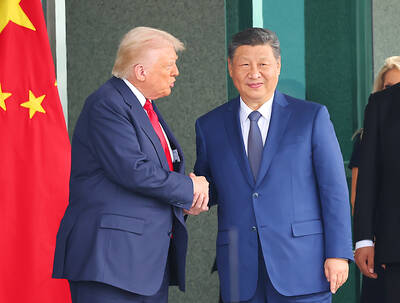Russia was yesterday due to make an interest payment on its foreign debt, the first since the West hit Moscow with sanctions over its invasion of Ukraine, which have raised concerns that Russia could default.
Moscow was due to pay US$117 million on two US dollar-denominated bonds.
Sanctions over Russia’s war in Ukraine have targeted US$300 billion of its foreign currency reserves held abroad.
Without access to these funds, concern has mounted that Russia could find itself forced to default.
Indicating an intent to pay, the Russian Ministry of Finance earlier this week announced that it had sent a payment order for “a total of US$117.2 million.”
Earlier, Russian Minister of Finance Anton Siluanov denied that Russia would not be able to make the payments.
He said Russia was prepared to service the debt in rubles, according to the exchange rate of Russia’s central bank on the day of the payment.
He also accused the West of pushing Russia toward an “artificial default.”
FIRST SINCE 1918
If Russia fails to make the bond payment, an automatic 30-day grace period kicks in and after its expiry, it would be considered in default on its foreign currency-held debt — a first since 1918, when Russian revolutionary Vladimir Lenin refused to recognize the debts of the deposed tsar.
Russia defaulted on domestic, ruble-denominated debt in the late 1990s.
Analysts at JPMorgan have said that US sanctions should not directly restrict Russia’s ability to service its debt.
According to the US Department of the Treasury, interest payments to US entities “are permissible through May 25,” on bonds issued by Russia’s central bank, finance ministry or national wealth fund before March 1.
After, they would need authorization to continue receiving these payments.
Western sanctions have crippled the Russian banking sector and financial system, and precipitated a collapse of the local currency.
A default automatically cuts a state from the financial markets and compromises a potential return for several years.

RUN IT BACK: A succesful first project working with hyperscalers to design chips encouraged MediaTek to start a second project, aiming to hit stride in 2028 MediaTek Inc (聯發科), the world’s biggest smartphone chip supplier, yesterday said it is engaging a second hyperscaler to help design artificial intelligence (AI) accelerators used in data centers following a similar project expected to generate revenue streams soon. The first AI accelerator project is to bring in US$1 billion revenue next year and several billion US dollars more in 2027, MediaTek chief executive officer Rick Tsai (蔡力行) told a virtual investor conference yesterday. The second AI accelerator project is expected to contribute to revenue beginning in 2028, Tsai said. MediaTek yesterday raised its revenue forecast for the global AI accelerator used

Taiwan Semiconductor Manufacturing Co (TSMC, 台積電) has secured three construction permits for its plan to build a state-of-the-art A14 wafer fab in Taichung, and is likely to start construction soon, the Central Taiwan Science Park Bureau said yesterday. Speaking with CNA, Wang Chun-chieh (王俊傑), deputy director general of the science park bureau, said the world’s largest contract chipmaker has received three construction permits — one to build a fab to roll out sophisticated chips, another to build a central utility plant to provide water and electricity for the facility and the other to build three office buildings. With the three permits, TSMC

TEMPORARY TRUCE: China has made concessions to ease rare earth trade controls, among others, while Washington holds fire on a 100% tariff on all Chinese goods China is effectively suspending implementation of additional export controls on rare earth metals and terminating investigations targeting US companies in the semiconductor supply chain, the White House announced. The White House on Saturday issued a fact sheet outlining some details of the trade pact agreed to earlier in the week by US President Donald Trump and Chinese President Xi Jinping (習近平) that aimed to ease tensions between the world’s two largest economies. Under the deal, China is to issue general licenses valid for exports of rare earths, gallium, germanium, antimony and graphite “for the benefit of US end users and their suppliers

Dutch chipmaker Nexperia BV’s China unit yesterday said that it had established sufficient inventories of finished goods and works-in-progress, and that its supply chain remained secure and stable after its parent halted wafer supplies. The Dutch company suspended supplies of wafers to its Chinese assembly plant a week ago, calling it “a direct consequence of the local management’s recent failure to comply with the agreed contractual payment terms,” Reuters reported on Friday last week. Its China unit called Nexperia’s suspension “unilateral” and “extremely irresponsible,” adding that the Dutch parent’s claim about contractual payment was “misleading and highly deceptive,” according to a statement